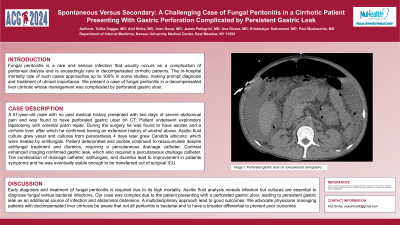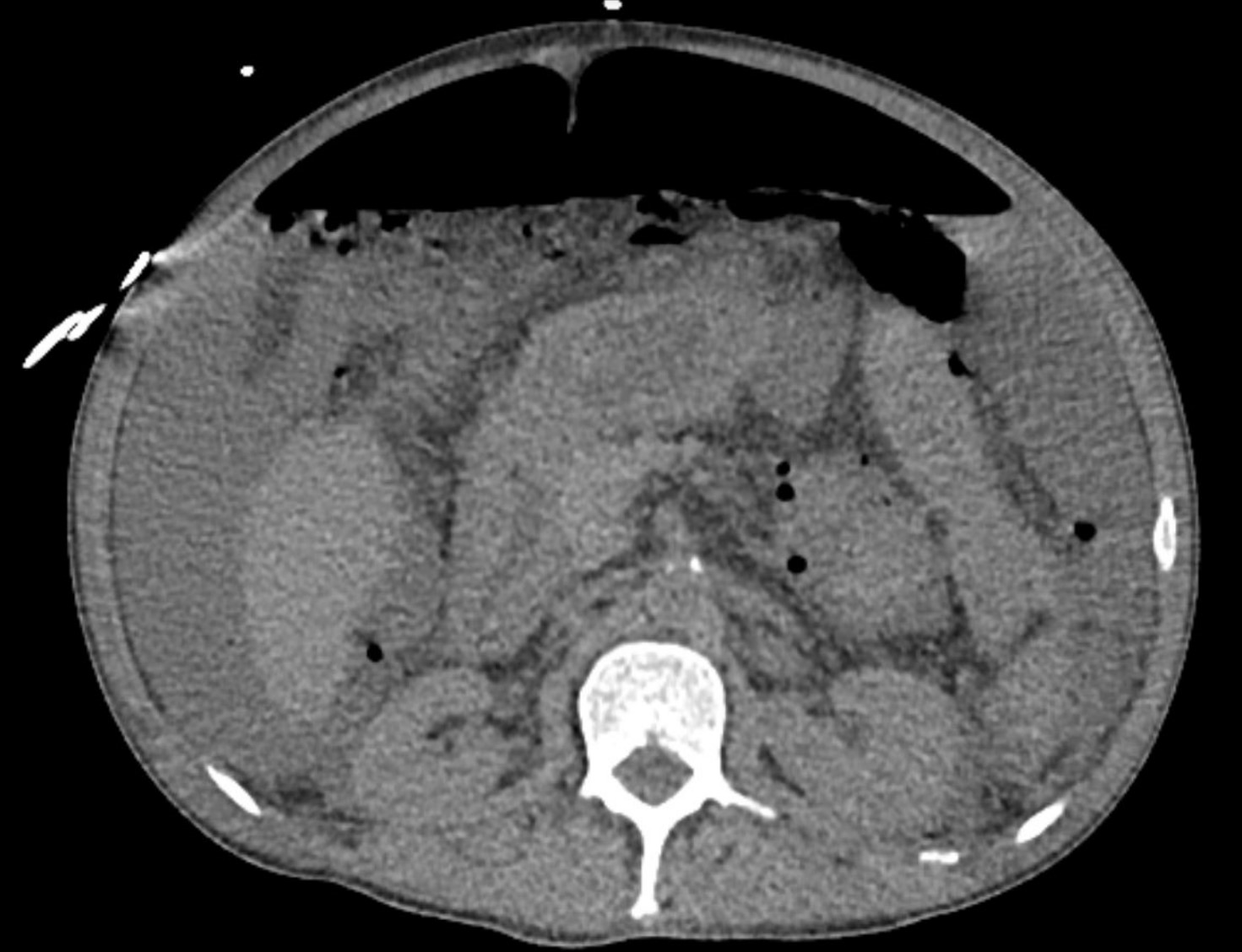Monday Poster Session
Category: Liver
P3149 - Spontaneous Versus Secondary: A Challenging Case of Fungal Peritonitis in a Cirrhotic Patient Presenting With Gastric Perforation Complicated by Persistent Gastric Leak
Monday, October 28, 2024
10:30 AM - 4:00 PM ET
Location: Exhibit Hall E

Has Audio
- AS
Atul Sinha, MD
Nassau University Medical Center
East Meadow, New York
Presenting Author(s)
Tulika Saggar, MD1, Atul Sinha, MD1, Jiten Desai, MD1, James R. Pellegrini, MD2, Ana P. Rivera, MD3, Krishnaiyer Subramani, MD1
1Nassau University Medical Center, East Meadow, NY; 2Nassau University Medical Center, Great River, NY; 3Nassau University Medical Center, Amityville, NY
Introduction: Fungal peritonitis is a rare and serious infection that usually occurs as a complication of peritoneal dialysis and is exceedingly rare in decompensated cirrhotic patients. The in-hospital mortality rate of such cases approaches up to 100% in some studies, making prompt diagnosis and treatment of utmost importance. We present a case of fungal peritonitis in a decompensated liver cirrhotic whose management was complicated by perforated gastric ulcer.
Case Description/Methods: A 51-year-old male with no past medical history presented with two days of severe abdominal pain and was found to have perforated gastric ulcer on CT. Patient underwent exploratory laparotomy with omental patch repair. During the surgery he was found to have ascites and a cirrhotic liver, after which he confirmed having an extensive history of alcohol abuse. Ascitic fluid culture grew yeast and cultures from paracentesis 4 days later grew Candida albicans, which were treated by antifungals. Patient deteriorated and ascites continued to reaccumulate despite antifungal treatment and diuretics, requiring a percutaneous drainage catheter. Contrast enhanced imaging confirmed gastric leak, which also required a percutaneous drainage catheter. The combination of drainage catheter, antifungals, and diuretics lead to improvement in patients symptoms and he was eventually stable enough to be transferred out of surgical ICU.
Discussion: Early diagnosis and treatment of fungal peritonitis is required due to its high mortality. Ascitic fluid analysis reveals infection but cultures are essential to diagnose fungal versus bacterial infections. Our case was complex due to the patient presenting with a perforated gastric ulcer, leading to persistent gastric leak as an additional source of infection and abdominal distension. A multidisciplinary approach lead to good outcomes. We advocate physicians managing patients decompensated liver cirrhosis be aware that not all peritonitis is bacterial and to have a broader differential to prevent poor outcomes.

Disclosures:
Tulika Saggar, MD1, Atul Sinha, MD1, Jiten Desai, MD1, James R. Pellegrini, MD2, Ana P. Rivera, MD3, Krishnaiyer Subramani, MD1. P3149 - Spontaneous Versus Secondary: A Challenging Case of Fungal Peritonitis in a Cirrhotic Patient Presenting With Gastric Perforation Complicated by Persistent Gastric Leak, ACG 2024 Annual Scientific Meeting Abstracts. Philadelphia, PA: American College of Gastroenterology.
1Nassau University Medical Center, East Meadow, NY; 2Nassau University Medical Center, Great River, NY; 3Nassau University Medical Center, Amityville, NY
Introduction: Fungal peritonitis is a rare and serious infection that usually occurs as a complication of peritoneal dialysis and is exceedingly rare in decompensated cirrhotic patients. The in-hospital mortality rate of such cases approaches up to 100% in some studies, making prompt diagnosis and treatment of utmost importance. We present a case of fungal peritonitis in a decompensated liver cirrhotic whose management was complicated by perforated gastric ulcer.
Case Description/Methods: A 51-year-old male with no past medical history presented with two days of severe abdominal pain and was found to have perforated gastric ulcer on CT. Patient underwent exploratory laparotomy with omental patch repair. During the surgery he was found to have ascites and a cirrhotic liver, after which he confirmed having an extensive history of alcohol abuse. Ascitic fluid culture grew yeast and cultures from paracentesis 4 days later grew Candida albicans, which were treated by antifungals. Patient deteriorated and ascites continued to reaccumulate despite antifungal treatment and diuretics, requiring a percutaneous drainage catheter. Contrast enhanced imaging confirmed gastric leak, which also required a percutaneous drainage catheter. The combination of drainage catheter, antifungals, and diuretics lead to improvement in patients symptoms and he was eventually stable enough to be transferred out of surgical ICU.
Discussion: Early diagnosis and treatment of fungal peritonitis is required due to its high mortality. Ascitic fluid analysis reveals infection but cultures are essential to diagnose fungal versus bacterial infections. Our case was complex due to the patient presenting with a perforated gastric ulcer, leading to persistent gastric leak as an additional source of infection and abdominal distension. A multidisciplinary approach lead to good outcomes. We advocate physicians managing patients decompensated liver cirrhosis be aware that not all peritonitis is bacterial and to have a broader differential to prevent poor outcomes.

Figure: Perforated gastric ulcer seen on CT
Disclosures:
Tulika Saggar indicated no relevant financial relationships.
Atul Sinha indicated no relevant financial relationships.
Jiten Desai indicated no relevant financial relationships.
James Pellegrini indicated no relevant financial relationships.
Ana Rivera indicated no relevant financial relationships.
Krishnaiyer Subramani indicated no relevant financial relationships.
Tulika Saggar, MD1, Atul Sinha, MD1, Jiten Desai, MD1, James R. Pellegrini, MD2, Ana P. Rivera, MD3, Krishnaiyer Subramani, MD1. P3149 - Spontaneous Versus Secondary: A Challenging Case of Fungal Peritonitis in a Cirrhotic Patient Presenting With Gastric Perforation Complicated by Persistent Gastric Leak, ACG 2024 Annual Scientific Meeting Abstracts. Philadelphia, PA: American College of Gastroenterology.
